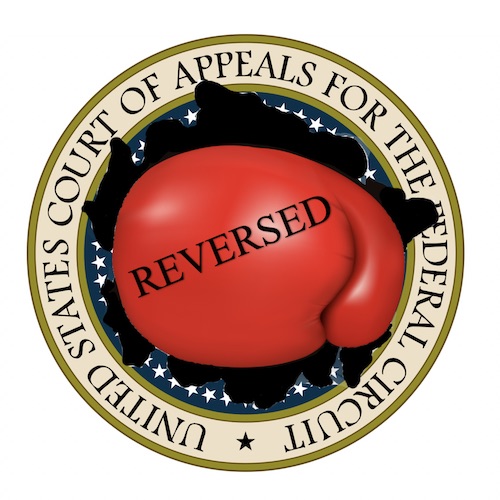“In this case, where the prior art evidences only failures to achieve that at which the inventors succeeded, no reasonable fact finder could find an expectation of success based on the teachings of that same prior art.” – CAFC
 On November 4, the U.S. Court of Appeals for the Federal Circuit (CAFC) reversed a decision by the U.S. Patent and Trademark Office’s Patent Trial and Appeal Board (PTAB) that University of Strathclyde’s patent claims for a method for photoinactivating antibiotic-resistant bacteria without using a photosensitizing agent were unpatentable. The PTAB held claims one, two, three, and four of U.S. Patent No. 9,839,706 (‘706 patent) were obvious based on the prior art. The court held the PTAB’s findings were not based on substantial evidence.
On November 4, the U.S. Court of Appeals for the Federal Circuit (CAFC) reversed a decision by the U.S. Patent and Trademark Office’s Patent Trial and Appeal Board (PTAB) that University of Strathclyde’s patent claims for a method for photoinactivating antibiotic-resistant bacteria without using a photosensitizing agent were unpatentable. The PTAB held claims one, two, three, and four of U.S. Patent No. 9,839,706 (‘706 patent) were obvious based on the prior art. The court held the PTAB’s findings were not based on substantial evidence.
The inventors found that exposing certain bacteria to blue or white light with a wavelength between 400-500 nm stimulated an inactivation process through numerous experiments. By experimenting with different filters that only allowed certain wavelengths through, the inventors came to the conclusion that visible-light exposure over certain wavelengths was a major inducing factor for inactivation. The inventors additionally concluded that exposing the bacteria to 405 nm blue light required less light energy for inactivation.
Inter Partes Review
Strathclyde filed for the ‘706 patent which claimed a method of disinfecting the air and other surfaces. Clear-Vu Lighting LLC (Clear-Vu) petitioned for inter partes review of claims one to four of the ’706 patent on four separate grounds. 1) claims one and three were anticipated by Nitzan; 2) claims two and four were obvious over Nitzan in view of Jones; 3) claims one and three were obvious over Ashkenazi in view of Nitzan; and 4) claims two and four were obvious over Ashkenazi in view of Nitzan and Jones. Since Strathclyde’s appeal focused on the finding regarding Ashkenazi and Nitzan, the CAFC focused on these references specifically.
Ashkenazi is an article that hypothesized that blue light may photoinactivate bacterial cells on a person’s body. Ashkenazi provided a method for photosensitizing Propionibacterium acnes (P. acnes). Ashkenazi was able to conclude from described experiments that “the greater the intracellular amount of the porphyrin the better are the eradication results.”
Nitzan is an article about the continued study of the effects of certain photosentizers on bacteria. The study found “a 1.0 survival fraction which means there was ‘no decrease in viability . . . after illumination’ with 50 J/cm² of 407-420 nm blue light.”
The PTAB determined that Clear-Vu did not prove that claims one and three were anticipated and claims two and four were obvious over Nitzan in view of Jones. The PTAB found that Clear-Vu failed to demonstrate how the results of the Nitzan demonstration showed inactivation of the bacteria.
The Board however did determine that Clear-Vu showed enough evidence that claims one and three were obvious over Ashkenazi in view of Nitzan and claims two and four were obvious over Ashkenazi in view of Nitzan and Jones. The PTAB held that Nitzan and Ashkenazi teach or suggest all of the limitations of claims one and three, and the reasonable expectation of success would motivate a person of ordinary skill in the art to combine Nitzan and Ashkenazi.
Review of the PTAB
Strathclyde challenged the PTAB’s obviousness determination by arguing the Board erred in finding that Ashkenazi and Nitzan in combination teach not using a photosensitizer to inactivate bacteria. Strathclyde further argued the PTAB’s determination that there was a reasonable expectation of success was not supported by substantial evidence.
The CAFC concluded that the finding regarding combining Ashkenazi and Nitzan to teach the limitations of claims one and three of the ‘706 patent were not supported by substantial evidence. Claims one and three require that the claimed bacteria be exposed to blue light without using a photosensitizer and the bacteria are inactivated as a result. Ashkenazi teaches that exposing bacteria to blue light achieves inactivation, but a photosensitizer was used. Nitzan teaches exposing bacteria to a blue light without any photosensitizer but no evidence was provided that inactivation was achieved.
Clear-Vu argued that a person skilled in the art would have prepared a culture according to Nitzan and applied the teachings of Ashkenazi that changing the light energy could result in greater inactivation. The PTAB agreed with this argument, highlighting that combining these two references would “disclose exposing bacteria to light without using a photosensitizer.”
The CAFC concluded neither Ashkenazi nor Nitzan teach inactivation of any bacteria without using a photosensitizer and failed to see why a skilled artisan would not opt to use a photosensitizer when examining these two references together. The court found it particularly relevant that in Nitzan the photosensitizer-free embodiment was unable to achieve inactivation of the bacteria.
Additionally, the court was not persuaded that Ashkenazi and Nitzan disclose the “inactivating” language found in claims one and three as Clear-Vu argues. The claims require exposing the bacteria to blue light within the 400-420 nm light without the use of a photosensitizer.
Reasonable Expectation of Success
The PTAB found that a skilled artisan would have expected that exposing bacteria to blue light without a photosensitizer could inactivate the bacteria because of the presence of naturally produced porphyrin in bacteria. The CAFC found that the only support for such a claim is purely conjecture coupled with hindsight bias of the teachings of the ‘706 patent.
The PTAB relied on Ashkenazi’s teaching that blue light may inactivate other bacterial cells that produce porphyrins. However, there is no indication of record at the time of the ‘706 patent to support this assumption according to the CAFC. The only evidence available was to the contrary in both Nitzan and an earlier publication. The PTAB dismissed the data reported in Nitzan because it viewed that a skilled artisan would have been led to the limited conclusion that increased light energy would lead to inactivation.
The CAFC concluded that this reasoning has no support in the record. The only evidence before the PTAB regarding this issue was the testimony of Strathclyde’s expert witness, who testified to the opposite of the PTAB’s findings. The PTAB gave no weight to the expert testimony because they felt the underlying facts of the expert’s opinion were not provided. The court held that the stated reasons that the PTAB gave for disregarding the expert’s testimony were unsupported meaning the CAFC gave no deference to the PTAB’s discretion concerning expert credibility.
The court continued:
Thus, not only is there a complete lack of evidence in the record that any bacteria were inactivated after exposure to 407–420 nm blue light without using a photosensitizer, there is also evidence showing that others had failed . . . We have found that such failures undermine a finding of a reasonable expectation of success.
Clear-Vu’s final argument was that support for the PTAB’s findings could be found in the ‘706 patent itself for reasonable success. The court found this to be the very definition of hindsight bias. When analyzing an inventor’s path, the path of a person with ordinary skill in the art should be followed by the relevant prior art and not the inventor’s own path. The CAFC does not require “absolute predictability” or “guaranteed success” to find a reasonable expectation of success, but only a reasonable expectation. “In this case, where the prior art evidences only failures to achieve that at which the inventors succeeded, no reasonable fact finder could find an expectation of success based on the teachings of that same prior art,” wrote the court.

![[IPWatchdog Logo]](https://ipwatchdog.com/wp-content/themes/IPWatchdog%20-%202023/assets/images/temp/logo-small@2x.png)

![[Advertisement]](https://ipwatchdog.com/wp-content/uploads/2024/04/Patent-Litigation-Masters-2024-sidebar-early-bird-ends-Apr-21-last-chance-700x500-1.jpg)

![[Advertisement]](https://ipwatchdog.com/wp-content/uploads/2021/12/WEBINAR-336-x-280-px.png)
![[Advertisement]](https://ipwatchdog.com/wp-content/uploads/2021/12/2021-Patent-Practice-on-Demand-recorded-Feb-2021-336-x-280.jpg)
![[Advertisement]](https://ipwatchdog.com/wp-content/uploads/2021/12/Ad-4-The-Invent-Patent-System™.png)







Join the Discussion
9 comments so far.
B
November 9, 2021 12:29 pm@ MCI “The PTAB always puts the burden of proof on the applicant to rebut the examiner’s unsupported conclusions.”
So very true.
The CAFC does the same thing from time to time.
It’s as if the PTAB and CAFC never read the APA
MaxDrei
November 8, 2021 06:44 amI note with interest that the EPO family member, 1924323, granted in 2016 over Ashkenazi after a torrid examination on the merits, has a much less wordy main claim, but with in substance the same features (400-420 nm and no photosensitizer).
Andrew Fortney
November 6, 2021 02:08 pmAgree with Comment 1. I’ve had a number of cases in which the PTAB substituted their own (il)logic based on pure conjecture (no evidence in the record) to support a rejection. Few clients can afford an appeal to the CAFC, especially considering that a whopping 2% of PTAB appeals are reversed there. Makes it difficult to talk with clients about justice through the PTAB and the US legal system.
Pro Say
November 6, 2021 01:00 pmEnough already with all this alleged “clarifying” of laws, statutes, and standards.
eBay, KSR, Mayo, Alice, etc were extrajudicial, often unconstitutional CHANGES.
You know it. I know it. We all know it.
Let’s all agree to stop letting the judiciary off the hook when they (we’re looking at you, SCOTUS and the CAFC) go rogue by calling the CHANGES they make . . . “clarifications.”
Just a person
November 6, 2021 12:04 pmThe particular decision aside, is this not a natural phenomenon as-claimed? It is surprising that the claims were allowed without any limitation on illumination power in the “portion of the visible light… consist[ing] of wavelengths in the range 400 – 420 nm”. It seems the PTO felt the method should not be patented, but applied the wrong statute and built a bogus case of obviousness (which the Federal Circuit rightly corrected here). As-claimed, this method has been performed by the sun for as long as these bacteria have existed. There likely is an invention here, but the claims are just too broad.
Pro Say
November 5, 2021 05:00 pmHa! The PTAB and the no-shame Solicitor’s Office were no doubt expecting a Rule 36 rubber-stamping of these ridiculous, not-even-close rejections.
Thankfully, the CAFC kept their rubber stamp in the drawer on this one.
Now, about all those ridiculous, twist-Alice/Mayo to suit, Rule 36’s and decisions . . .
Moderate Centrist Independent
November 5, 2021 04:55 pmThe PTAB always puts the burden of proof on the applicant to rebut the examiner’s unsupported conclusions.
Here to correct misinformation
November 5, 2021 12:33 pmThe standard didn’t need clarifying. What is needed is for even one APJ to understand the standard for reasonable expectation of success. And to understand that the burden of establishing it is on the PTO. The burden is not on the applicant/patentee to establish that there is no reasonable expectation of success.
And it’s not even clear that the Fed. Cir. understands it. If the only way for them to find no reasonable expectation of success is when “the prior art evidences only failure to achieve that at which the inventors succeeded” then they don’t really understand it either. Yet at least managed to get the correct result. Thank goodness for small favors I guess.